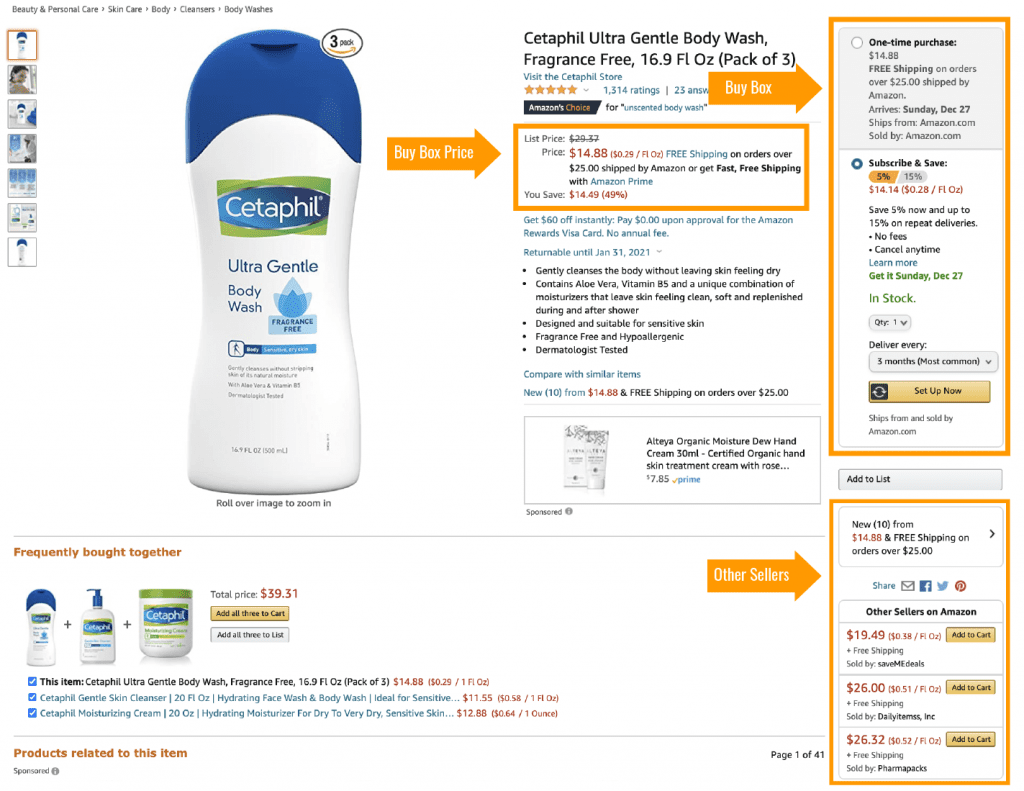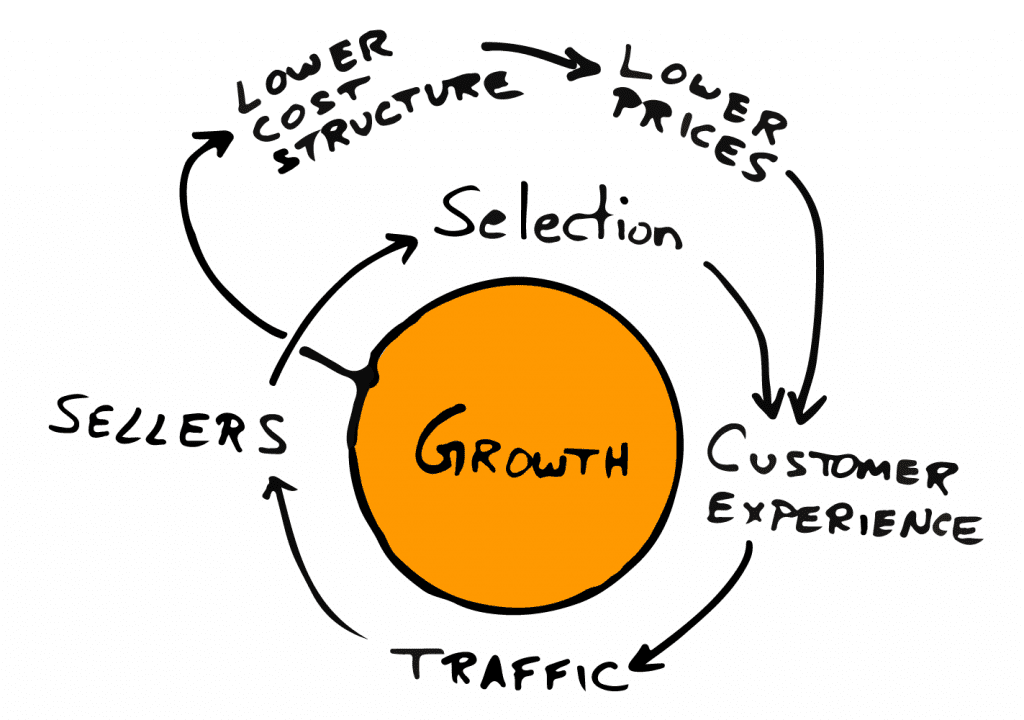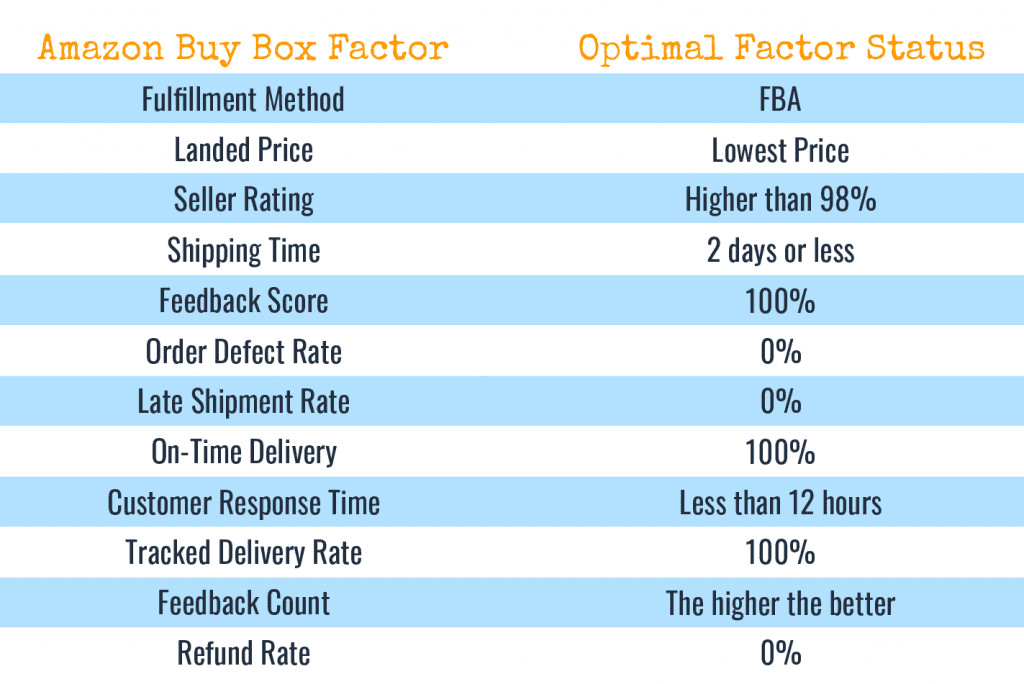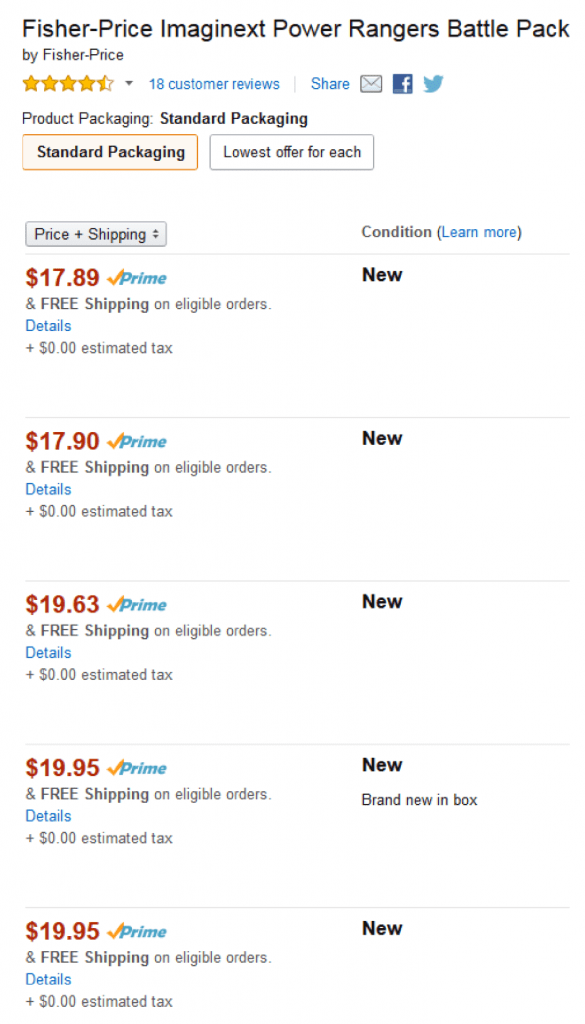
It all starts with the buy box.
The Amazon Buy Box is a key component in maximizing your sales in the marketplace. In fact, the vast majority of sales (most estimates being 80%+) happen from inside the Buy Box. When you take that factor into consideration, you quickly begin to realize the importance of increasing your share of the Buy Box, and the impact that it can have on your sales.
So, what is the Buy Box exactly?

The name buy box is pretty literal. As you can see in the picture it is the area on a product detail page where a customer actually clicks to add a product to their cart.
So the question is if there are multiple sellers on a given product, who gets the sale when a customer clicks “add to cart” using the buy box?
The answer is that Amazon automatically selects the seller using a set of metrics that for the most part, they try to keep a secret. Fortunately, we have figured out most of those metrics and will be sharing them with you in this guide along with strategies to help increase your buy box exposure, increase your ability to analyze products so you make better buying decisions, and ultimately…increase your sales.
What Factors Determine Buy Box Percentage?
It is important to mention here that Amazon does not give the exact recipe for success in maximizing the amount of time each seller gets in the Buy Box. However, they do give examples as to some of the factors that they consider in determining the Buy Box percentage for sellers. Through experience and years of study, we have learned more factors that help to increase your Buy Box percentage and help to give you an edge in maximizing your sales.
Here are the known factors that Amazon uses to determine who gets the Buy Box:
Fulfillment Method
Buy Box Impact: Very High
We believe this to be the KEY factor in determining Buy Box eligibility. Selling on Amazon allows for two different methods of fulfillment:
Fulfillment by Amazon (FBA) & Merchant Fulfilled
You can see Amazon’s preference of FBA offers in two fashions:
- FBA Offers are Prime Eligible – it is only recently that they allowed a select few Merchant Sellers to become eligible to offer Prime Shipping (in an Invite Only Pilot program).
- FBA Offers (more appropriately Prime Eligible Offers) – are able to be priced higher than traditional Merchant Fulfilled offers and receive Buy Box eligibility. This varies by percentage as to how much higher and is generally decided by the other factors like Seller Metrics. We have, however, seen offers as high as 25% higher than the Merchant Fulfilled offers and still be Buy Box eligible.
Either way that you look at it, Fulfillment Method plays a HUGE role in determining Buy Box eligibility. In a nutshell, FBA is the superior method for selling to gain buy box control most frequently.
Price
Buy Box Impact: Very High
Amazon focuses on delivering extreme value to their customers. Amazon believes that lower prices help to create better customer experiences for their customers, which helps to drive more traffic to their site. We personally believe that this is the second most important factor in determining Buy Box eligibility.
For more information about how Amazon perceives price to be an integral part of their system – review the Amazon flywheel diagram below.

Feedback Score
Buy Box Impact – Medium
This particular facet is rather self-explanatory. Feedback serves as an indicator of customer experience when buying from you. It is very important that you, as a seller, work as hard as possible to improve your customer’s experience. This means making sure that customer inquiries are answered in a timely fashion, that your products are carefully matched to the Amazon detail page and that you work diligently to resolve any customer issues.
Likewise, it is very important that you monitor your feedback and contest any feedback that goes against the Amazon guidelines. In instances where your feedback may not be eligible for removal by Amazon, we suggest that you work with the customer to get the feedback removed (within Amazon’s rules of course).
To understand how important customer experience is at Amazon we have included a link to the 14 Leadership Principles at Amazon for your review.
https://www.amazon.jobs/en/principles
Feedback Quantity
Buy Box Impact – Medium
This is an indicator to Amazon of the volume of sales that you do, as well as provides them with a long-term gauge for customer experience. Their goal is to perpetuate sales from sellers who are likely to provide a positive customer experience. To help increase the amount of feedback that you get – you can look at using a customer correspondence service like Salesbacker, FeedbackFive (www.ecomengine.com/feedbackfive), or Feedback Genius. These services can be used to prevent bad feedback by encouraging customer interaction in the instance of a problem and similarly to promote buyers to leave positive feedback.
Perfect Order Score
Buy Box Impact – Medium
These are comprised of: Customer Inquiry Response Time, Order Defect Rating (ODR), Return %. These are all great metrics for Amazon in helping them understand how you interact with customers. The great news is that all of these factors are within your control (directly or indirectly).
Quantity of Product Available
Buy Box Impact – Low
You will get the Buy Box with a higher percentage the more inventory that you have available. Amazon likes competition, as competitive markets generally have downward price pressure as sellers compete to get more sales. Looking at this intuitively, the longer they keep sellers on a listing – the more competition that will exist, which can inherently lead to downward price pressure.
This is an interesting conundrum as having more inventory leads to higher Buy Box percentages and consequently higher sales, but likewise has higher fees involved. It’s important that you play a balance here, as you certainly don’t want to encounter Long Term Storage fees in hopes raise your Buy Box percentage by a small amount.
Proximity of Product to the Customer
Buy Box Impact – Low
This factor is important to Amazon on several levels. Their goal is for customers to receive the product as quickly as possible, and secondarily it certainly helps their freight costs to not ship products across the country. We aren’t sure how important the factor of stickered vs. commingled in this regard is, but one could assume that having commingled inventory would mean your inventory is inherently closer to the consumer as it doesn’t have to be your inventory, but that is unconfirmed and speculatory.

Accurately Estimating How Often A Product On Amazon.com Sells
It is possible to look at a product on Amazon and get a pretty good idea of how fast, how often and how many times you can sell a product (assuming you are actively competing for the buy box). The best part is that you can do all of this with free tools.
The first step is to figure out how many times a product on Amazon sells per month.
To do this, you can use JungleScout’s free estimator on their website here. Simply plug in the Amazon Best Sellers Rank and it will give you a readout:
Through extensive testing and our own data, we have found the tool to be an incredibly accurate estimation. If you want to see how we use Jungle Scout in our wholesale sourcing (although it can be great for Private Label research as well) then check out our video here:
JungleScout Webinar with Dan Meadors & Greg Mercer
Tip: It can also be beneficial to view the average sales rank of a product and run it through JungleScouts free estimator, just in case there have been any recent fluctuations. Camelcamelcamel.com is a great website to see the sales rank of products charted over periods of time.
Estimating How Fast and How Often YOU Can Sell A Product on Amazon.com
Now that you can determine how many times a product sells in total every month, with just a couple more steps you can determine around how many of those sales YOU are entitled to.
(All calculations here assume you are always competing for the buy box based on criteria we previously mentioned and your fulfillment method is FBA)
Let’s assume you are looking at a product that JungleScout determines will sell 100 times per month. To figure out how many you can sell out of that 100 in a month, our next step is to figure out how many sellers on the product are eligible for the buy box.
The game really changes whenever you realize you aren’t competing with the multitude of sellers who are on the listing. In fact, the vast majority of these sellers have NO shot in their current capacity on the listing of actually making a sale. This will make products that you have previously skipped over appear much stronger when you realize the sales potential that you might have previously been overlooking.
The first thing that we do, in general, is only consider Prime eligible offers to be competitive. There are caveats to this, where the merchant offers are significantly less than their Prime eligible counterparts. One great way to realize whether a Merchant
Fulfilled (MF) offer is Prime Eligible, is to look at the current Buy Box, are they the featured Buy Box merchant. If their price is cheaper, and they are not the featured merchant, then it is fairly reasonable to assume that they are not Buy Box eligible.
The next thing that we will look at is which of those Prime eligible offers are competitively priced. We define competitively priced as being within two percent of the lowest Prime eligible offer. We have found that the majority of the time, those sellers will have some amount of Buy Box eligibility when they are within two percent of the Buy Box. While, if they are priced higher than the lowest FBA offer – they will get a lesser percentage equity in the Buy Box – they will still, in many cases, get some of those sales.
So what does this look like?

As you can see, you simply look at the offers tab to view all offers and then locate the lowest Prime Eligible offer. We simply take that initial Lowest Prime Offer and multiply it by 1.02, which will give us the highest price that we consider to be competitive.
In this example:
$17.89 * 1.02 = $18.25
Therefore, any seller above the price of $18.25 is highly unlikely to get shares of the buy box.
If you came onto this listing priced at under $18.25 you would be the 3rd competitive seller. Assuming all buy box metrics are equal among sellers, and this product sells 100 times per month, you could expect to sell this product 33 times in a month. Or once per day. So for instance, if you only sent in two units of this product, you could expect to sell both of them in just a few days.
What if your buy box metrics outside fulfillment method and price aren’t great? There is no exact science for that, but the worse your metrics are, the worse of a percentage you can expect to gain.
Now of course the landscape for a product can change between when you look at it and when your product arrives at Amazon’s fulfillment centers, but this method gives us the best idea of what to expect with the data we have available to us.
This might all seem complex, but I have got good news for you. We have developed a Google Chrome Extension that does all this calculating and counting for you. It is called the TWF Buy Box Scope and you can download it here for free:

This extension simply does the above calculation for you and helps to automate the process of determining which offers are competitive, such that you can move forward in your product analysis in determining your projected quantity that you will sell-through.
Now no matter if you are making a Retail Arbitrage, Online Arbitrage, or Wholesale purchase…you can easily and accurately estimate how many you should buy and how long they will take to sell.
So let’s recap all this into simple steps:
Step 1: Use JungleScout to determine the monthly sales of a product
Step 2: Use The TWF Buy Box Scope to determine how many competitive sellers it has and add one more (which will be you)
Step 3: Divide the monthly sales by the number of competitive sellers (plus you) and that should be your monthly sale through of the product.
Final Thoughts
This was really revolutionary in helping us understand the Amazon marketplace, and has led to several breakthroughs in growing our business. Knowing that you have the ability to make sales is certainly a great feeling, but truly understanding how and why sales occur can give you a HUGE advantage in the Amazon marketplace.
The key to our growth has not only been learning these things about the marketplace but studying to learn how we can use them to grow our business. After reading this article, you should have a much better understanding of how you can affect your own sales – the ways that you can improve your business strategy to improve your Buy Box percentage, as well as determining what might be a great prospective product. I wanted to make it abundantly clear that this information is not only applicable to wholesale, on the converse it applies to any volume purchase situation (where you can control the amount of product that you buy) like Retail Arbitrage, Online Arbitrage, or purchasing Liquidation. It should give you an idea about how you can project your cash flow, and when you should invest your money.
